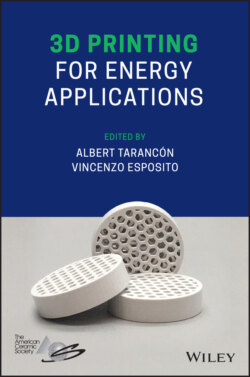Читать книгу 3D Printing for Energy Applications - Группа авторов - Страница 24
1.2.1 Geometric Gradients in PBF
ОглавлениеPorous metals in various forms, including foams and lattices, have been investigated for many years for a wide variety of applications [24, 25]. These range from lightweight structures to functional applications such as heat exchangers or electrodes. Cellular solids have been investigated to determine relationships between their geometry and their physical properties (thermo‐mechanical, acoustic, impact‐toughness, etc.). The motivation for much of this research is high‐performance applications; for example, in simultaneous structural light‐weighting and sound dampening in motor vehicles/aircraft, thus providing high functionality with minimized resource consumption. Recent advances in lattice design have enabled the creation of structures with spatially varying solid volume fraction; these are termed as functionally graded lattices. Gibson‐Ashby models have developed a theoretical framework for cellular lattice materials that are well suited for generating topology optimized designs. Powder bed fusion systems are uniquely suitable to manufacture the highly complex lattice structures with struts as small as 100 μm.
Maskery et al. [26] investigated the mechanical properties of graded density Al‐Si10‐Mg lattice structures manufactured by L‐PBF for structural applications and found significant improvement in compressive and impact strength. Choy, Sun, Leong, and Wei [27] showed similar improvements in mechanical properties for Ti‐6Al‐4V. Li, Hassanin, H., Attallah, Adkins, and Essa [28], and Tan et al. [29] investigated TiNi Shape Memory Alloys (SMA) fabricated by L‐PBF. The process conditions that lead to the microstructural characteristics play a major role in the SMA alloy properties. L‐PBF of TiNi lattices can enable tailored properties, in addition to the functionality associated with the shape‐memory effect. Li et al. [28] used a topology optimized design to manufacture a negative Poissons ratio metamaterial.
Functionally graded metal lattice structures with tailored mechanical response are most commonly used in biomedical applications like implants. The human bone is a functionally graded anisotropic structure, and hence any biocompatible implants need to have similar mechanical performance. A large surface area also helps toward osseointegration and thus leads to fewer implant rejections. A large body of research thus focuses on scaffolds of biocompatible materials like CoCrMo, Titanium alloys, and, more recently, biodegradable alloys of Mg, Zn, and Fe [30]. Hazlehurst, Wang, and Stanford [31] investigated L‐PBF of CoCrMo FGMs to imitate bone for a hip implant that is half as light, and twice as flexible compared to a solid metal structure. Ataee, Li, Fraser, Song, and Wen [32] researched high porosity (82–85%) Ti64 scaffolds with varying unit cell dimensions by EB‐PBF and found that the ratio of elastic modulus anisotropy in orthogonal directions was comparable to those of a human trabecular bone. Yan, Hao, Hussein, and Young [33] and Yu, Sun, and Bai [34] focused on increasing the surface area by using Triply Periodic Minimal Surfaces (TPMS) in their lattice designs. Zhang, Fang, Leeflang, Zadpoor, and Zhou [35] took an alternate approach through a stepwise topological design based on diamond unit cells to mimic the structure of the femoral diaphysis through L‐PBF of Ti‐6Al‐4V.
